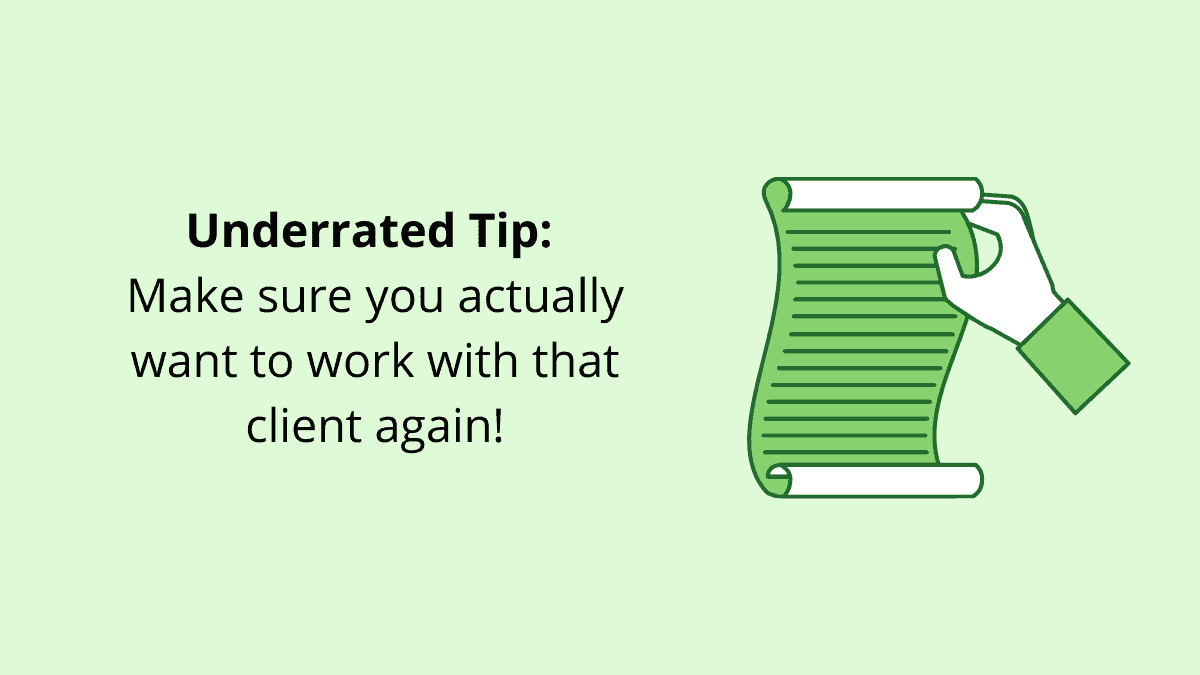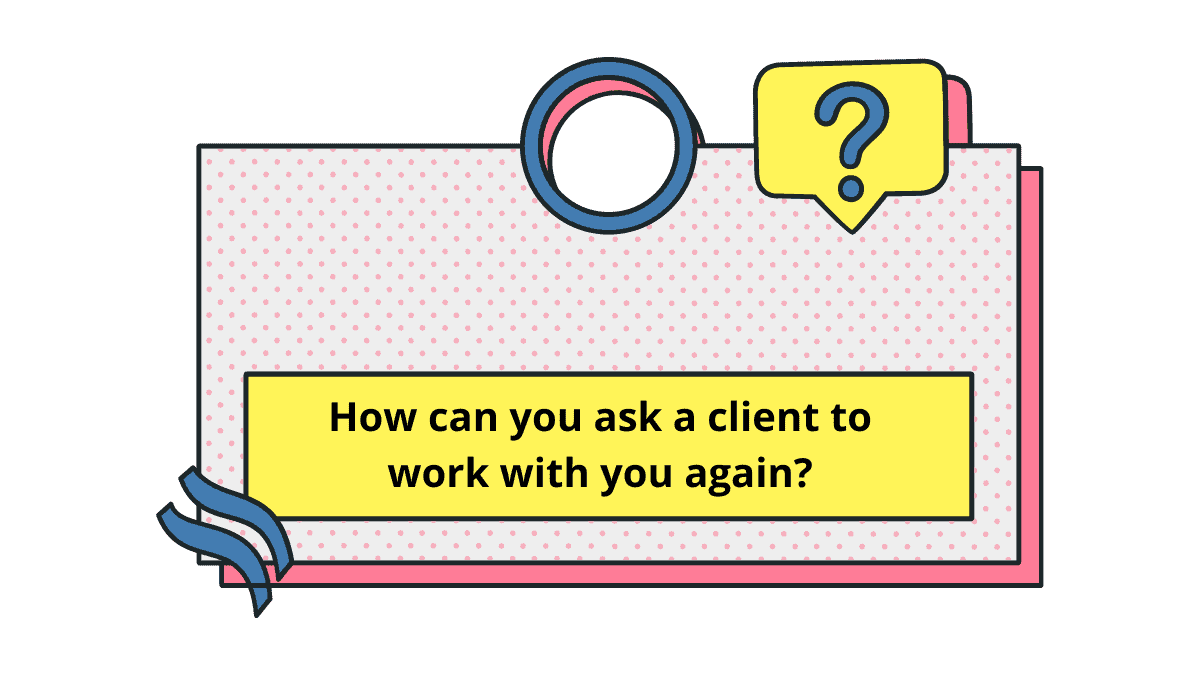As they say, “it’s easier to keep an existing customer than find a new one”. Same goes for your freelance clients.
After all – long-term clients are every freelancer’s daydream. They provide a repeating income and familiarity. Loyal clients can be a HUGE boost to your career confidence, and they can bring us freelancers the stability we crave.
However, persuading a client to commit isn’t always easy. Today, I’ll share some solid strategies for turning your one-off customers into loyal clients!
Who am I to talk about this? Well, I’ve been on both sides, as a long-time freelance writer and a client too.
I’m now employed full-time by one of my old clients… to manage a team of talented freelancers. So I’ve got a few insights up my sleeve!
Here are 3 of my favourite forms of these long-term clients:

These are the clients who worked with you in the past and had a great experience. They left that project nodding and feeling satisfied. And, guess what? The next time a project arises – you’re the first freelancer that pops into their head.
These types of clients are awesome. Some of my favorite clients fall into this category – and we’ve stayed in touch for years. These clients will provide jobs throughout your career without tying you down, and without kicking up a hissy fit if you update your rates.
The only downside? The work isn’t always regular.

Retainer clients are the closest things freelancers have to being on payroll. By signing a retainer agreement, your client promises to pay you a set rate each month for a certain amount of work.
These sorts of retainers work best for freelance services that can be repeated every month – e.g legal services, blog writing, and virtual assistant tasks. You might agree to commit a certain number of hours to the client, or just agree to complete certain tasks.
The best thing about retainers is that they give you greater financial security. You can rely on having a certain income, which makes it easier to budget your finances. Plus – you’re more likely to be paid on time!
This one is a slight variation of the retainer – I like to think of it more like a ‘subscription’.
Instead of forming a contract based on the hours or work done, these clients agree to purchase some sort of ongoing product/service from you.
For example – you might offer to run an expert training session with your client’s team every 2 weeks, where you share the latest developments in your industry.
The great thing about this is that you aren’t as ‘stuck’ to them as a regular retainer agreement. You won’t need to worry about things like scope creep, or client exclusivity.
How likely you can secure these 3 types of clients depends on one main thing: how great you are to work with.
As someone who’s hired a lot of freelancers – take it from me. Many clients hate the finding-a-reliable-freelancer thing. It’s time-consuming, and we don’t know if you’re going to work hard, or turn out crazy.
I’d MUCH rather engage a freelancer I’ve worked with before… if I was happy the first time round. Because it’s not JUST about delivering high-quality work. It’s about proving your worth ethic too.
I’ve found the following 4 freelancer tactics make the biggest difference.
Make a sincere effort to connect with your clients. I’ve been lucky to become friends with some of my clients. It’s not always possible, but you can ALWAYS treat clients with friendliness, respect and honesty.
A sense of humor can also go a long way. The more enjoyable you make the experience of working with you, the more likely they’ll choose you again and again.
Prove that you’re trustworthy. If you say you’re going to do something, do it! And if something goes wrong – be communicative.
As a client, I’m baffled at the number of freelancers I’ve worked with who’ve missed deadlines, or go MIA for a week mid-project. Sure, we’re all human – but if you make a habit out of being sloppy, expect to get droppy.
Position yourself as someone who will be around in the long-term. Try and understand your client’s long-term goals and challenges – then be their rock.
When you pitch a client at the start of the project – you can hint that you enjoy working towards long-term relationships with clients. At the end of the project, remind them they can come to you anytime.
Another great tactic is to share helpful resources. For example, if you find a useful video about a specific challenge they’re facing, why not send it over? Chances are, they’ll be pleasantly surprised and grateful – it may even spark a new collaboration.
Don’t shy from asking for feedback. For example, when a project has ended, you can ask the client how they felt about working together and if they have any suggestions for improvement (preferably do this over email or a call, rather than a public review).
Not only will this improve your work – the act of asking shows that you actually care. You’ll stand out from all the other freelancers who didn’t bother.
So, how can you start turning your one-time clients to long-time clients?
Start by making a list of all your clients – past and current, ex-colleagues and managers included.
Then – narrow it down to those clients you enjoyed working with.

Since you’re going to devote a chunk of your time to these clients, you’ll need to make sure they can embellish your career growth. Is it the type of work you WANT to keep adding to your portfolio?
Someone more likely to become a long-term client is…
Someone that less likely to become a long-term clients is:
Whether you can turn a client loyal depends on one thing: your ability to convince them that you can solve their biggest problems.
Before you approach them, prepare what you’re going to say. You can’t just break down the door and wave a contract in their face.
Instead, draft out a proposal. It doesn’t have to be long or fancy. It just needs to be an idea of a project that both of you can get excited about. The trick is to figure out what project will work in your benefit, and reframe that as an opportunity for the client.
Because, sure, you’re asking for more/regular work. But you’re also offering a long-term solution to their problems.
If you haven’t been in contact with them for a while, now’s your chance to remind them what you can bring to the table. What can you do that no one else can?
Is it all the dazzling testimonials you got from clients on a similar project? Your unique blend of talent + passion? Or the fact your last article for them, was shared 3,000 times on Facebook?

In short – don’t be scared of asking. Here’s some quick examples of when and how you can pitch for a long-term relationship:
“This looks great. It looks like it might need some updates every few weeks, which I’d be happy to help with regularly. Would you be open to an arrangement like that?”
“The first milestone went very smoothly, and I can see it being a big success for you. Maybe we can consider something more long-term where I can help you get results like this on a regular basis. Would you be interested?”
“That wraps it all up. Thanks, a lot [client name]! I’d love to chat about ways we could work together more regularly in the future so we can keep driving results for you. Is that something you’d want to discuss?”
“Congratulations! I see the project is live and has really exceeded expectations! That’s great! I enjoyed working on it as well. I would like to work on more projects with you to keep the momentum going, are you interested?”
However you say it, just be casual and gauge your client’s interest levels. Once you’ve got them hooked, you can talk about the details (which you’ve prepared with the proposal).
You’re not limited to the 4 examples above. If you have a great idea of how to add value on a recurring basis, why not pitch it? Heck, some freelancers prefer to put a pitch for a retainer in every initial proposal they write. It can work.
Of course, don’t want to be too pushy and scare your clients off. Keep it low-key and casual, so they don’t feel like you’re being a hard sell. Some clients will buy into it, some won’t. You won’t know until you take your shot.

If a client isn’t interested, don’t take it to heart.
Plus, client demands are constantly changing. Perhaps as a client’s business grows, they’ll have more needs and a bigger budget.
Don’t burn your bridges. The trick is to stay positive, offer your support and leave the door open. Then – you’ll stay fresh in clients’ minds when the time comes.
Before I go, there’s something I want to remind you: even though having long-term clients is awesome, it isn’t a life sentence! Don’t be afraid to drop a bad client if the relationship turns toxic, and they start taking you for granted.
End of the day, your client probably wants the same thing as you. A dependable relationship that helps them hit their professional goals, so they can earn a living and sleep easy at night.
The best thing you can do is to work hard, communicate your value, and stay in touch.
If it still doesn’t happen after you’ve done all that – well, their loss. Next!
Dani is an editor and writer based between KL and Mexico City. Sprung from the advertising and travel industries, she’s also spent the last 10+ years freelancing for a slew of creative online businesses around the world. Connect with her via LinkedIn.